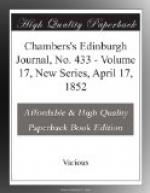They destroyed no more than ten white bears; these animals defended themselves with prodigious strength and fury. The first was attacked by the sailors; the other nine were the assailants. Some of them were so daring as to walk into the hut in search of their prey. Those among them who were the least voracious were easily driven away, but the more ravenous were not to be deterred; and it was not without encountering the most imminent danger that the men escaped in the dreadful conflicts. But they were in continual fear of being devoured, as these ferocious animals repeated their visits to the hut, and renewed their attacks continually. When they succeeded in slaying one, they made use of its flesh as food, which, with that of the reindeer and the blue and white foxes, were the only kind they could have in that bleak region.
The want of the necessary conveniences obliged them for some time to make use of their food without cooking. They had nothing in the way of bread or salt. The stove within was set up after the Russian fashion, and could boil nothing. The cold was so intense, that all the wood they had was reserved for the stove; they had none to spare for making a fire outside, from which they would have had but little heat, and where they would run the risk of being attacked by the white bear. Besides, the masses of snow which fell during the winter months, and the heavy rains, would have made it quite impossible, for great part of the year, to have kept a fire burning in the open air. They, however, thought of a plan by which they were enabled to prepare some of their food. In the summer months, they exposed part of their animal food in the sun, and then hung it in the upper part of the hut, where it became thoroughly dried by the smoke. This food they used as bread, with that which they were obliged to eat half raw. By this means they were able to keep up a constant supply of provisions. They had water in the summer from the rills which fell from the rocks, and in winter, they were supplied from the snows and thawed ice. Their only utensil for holding water, and substitute for a drinking-cup, was their small kettle.




